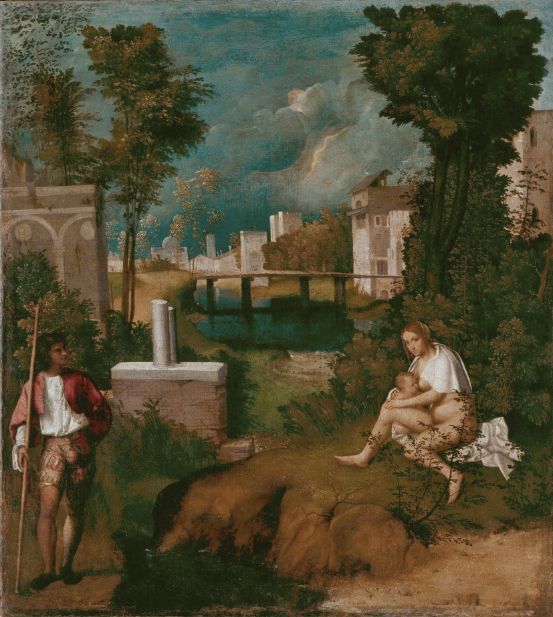Giorgione (circa 1476/1478-1510), whose full name was Giorgio da Castelfranco, after the small town of Castelfranco in the Venetian mainland, remains one of the most enigmatic and influential artists of the Renaissance. Despite the limited number of his surviving works—no more than six—Giorgione's artistic style and techniques had a profound impact on the Venetian School of painting.
Giorgione's painting techniques were unique and groundbreaking, particularly his use of light effects. He was the first artist in Venice to employ this new technique, blending pigments with oil and soft resins to create rich, opaque, and thickly applied brushstrokes. This method provided great expressive freedom in his paintings. As Vasari noted, Giorgione differed from Florentine artists by not making detailed sketches on paper or canvas. Instead, he roughly outlined the composition directly with opaque colors and gradually refined it with gradated tones, producing his characteristic soft contours, subtle atmospheres, and dreamlike qualities. These traits are evident throughout his body of work.
One of Giorgione's notable works is "The Three Philosophers" (completed by Sebastiano del Piombo, circa 1509). This painting depicts three scholars in a landscape, two standing and one observing the sunlight with a sextant. The painting not only confirms the description by the Venetian connoisseur Michiel but also reflects Giorgione's unique perspective on the purpose and meaning of art. His skillful use of light and shadow integrates the figures with their surroundings, creating a serene and mysterious atmosphere. The philosophers, although psychologically detached from one another, are compositionally inseparable from the lyrical rural scenery, demonstrating Giorgione's deep understanding of composition and light.

Another famous work often attributed to Giorgione, but also to Titian, is "The Pastoral Concert". This painting, depicting an idyllic pastoral scene, includes two nude women, a lute player, and a young man. The background features shepherds and sheep, evoking a classical pastoral theme. This work lacks a clear narrative, suggesting a visual poem that expresses a pursuit of harmony with nature. Through such works, Giorgione revealed his unique insights into human emotions, nature, and the interplay of light and shadow.

Giorgione's paintings are characterized not only by their technical and stylistic innovations but also by their thematic originality. As Michiel noted, Giorgione sometimes deliberately left details vague, as in "The Sleeping Venus." This approach allowed for greater interpretative space, inviting viewers to engage their imagination and contemplation.

Giorgione's influence extended beyond his own works; he played a crucial role in the development of Venetian painting techniques and styles. His student Titian inherited and further developed his techniques, solidifying the Venetian School as a significant artistic movement during the Renaissance. Titian's works demonstrate a profound understanding of light and color treatment, directly inspired by Giorgione's innovations.
Giorgione's art was not only about technical and stylistic advancements; it was imbued with a deep understanding of human emotions and nature. Paintings like "The Three Philosophers" and "The Pastoral Concert" reflect his profound contemplation of harmony between humanity and nature. His ability to evoke emotional resonance through his paintings allows viewers to experience the subtle and profound emotional atmosphere he created.

Giorgione's painting style is rich with poetic and mysterious elements, akin to visual dreams that immerse viewers in a fantastical world. His works are not just visual pleasures but also emotional and spiritual experiences. Through his paintings, Giorgione demonstrated the limitless possibilities and profound depth of visual art.
Despite the limited number of surviving works and the scant details of his life, Giorgione's artistic achievements and influence are undeniable. He left an indelible mark on Renaissance art history through his innovative techniques and unique style, impacting subsequent generations. His works, filled with extraordinary talent and deep intellectual content, are invaluable legacies in the history of art. Giorgione's paintings, akin to visual poems, offer endless imagination and reflection, ensuring his name shines brightly in the annals of art history.